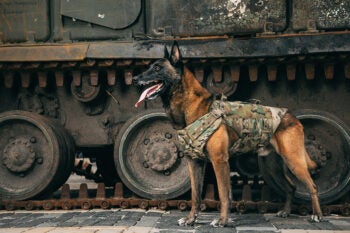Home /
Honoring K9 Veterans Day

March 13 is National K9 Veterans Day and the day we honor our K9 Veterans and their steadfast service to our nation. Courageous, loyal, unwavering are among the many descriptors we share to describe Military Working Dogs (MWD). How many times have we seen heroic pictures of our MWDs and their handlers doing the tasks they were trained to do? On a deployment, in the air, and on the ship, there are so many times these heroic pairs make the difference in ways we never thought possible.
K9 Veterans Day was founded by Joe White, who is a Jacksonville, Florida native, Vietnam War Veteran and K9 Handler. K9 Veterans Day honors the service and sacrifices of the US military and working dogs. March 13 was chosen because this was the day the US Army K9 Corps was founded in 1942.
The Department of Defense (DOD) finds its canine recruits from an elite group of Belgian Malinois breeders from around the world. And a select group (about 13%) are born and bred into the US military through the DOD Military Working Dog Breeding Program, aka the Puppy Program. These puppies come from one place: the 341st Training Squadron at JB San Antonio. About 50-90 puppies are born into the program every year.
While all dogs receive the same patrol training, not all receive the same detection training. Each dog trained in detection specializes in either narcotics or explosives detection, but not both. There are several different odors for dogs to learn for both narcotics and explosives, which is too much for a dog team to train and be proficient on so they must specialize in one or the other. There are also different tactics in detecting narcotics vs. explosives, and if the dog was trained on both and responds, how would this be communicated to know whether to call the bomb squad or narcotics unit? MWDs are trained to get as close as possible to the odor and then respond without ever touching it.
Handlers train MWDs to “apprehend” suspects, which means biting and holding on to them until the handler arrives to detain them. To minimize injury to both the dog and suspect, MWDs are taught to apprehend suspects by clenching down on a meaty part of the body such as an arm or leg. MWDs certified in patrol (bite work) are very capable of causing serious bodily harm, however, MWDs are not trained to kill or even bite vital areas of the body such as the head, neck, or groin.
There are both female and male Belgian Malinois MWDs. They have the same training and standards to become certified as military working dogs in both patrol and detection. The only real and obvious difference is females are generally smaller than males. However, in a military working dog world it’s not the size of the dog that matters, it’s the size of the fight in the dog. Well-trained female MWDs will fight at all costs to protect their handlers.
Our military working dogs are treated with the same respect as our service members. The US Army will medevac Military Working Dogs when injured in the line of duty. The US Army Medics on the Medevac helicopters are trained in basic canine anatomy and trauma medicine so they can stabilize a dog in case of emergency.
Please take a minute and honor the service of our K9 Veterans and their Handler’s. They are an invaluable team that has saved countless lives past, present and certainly in the future.


